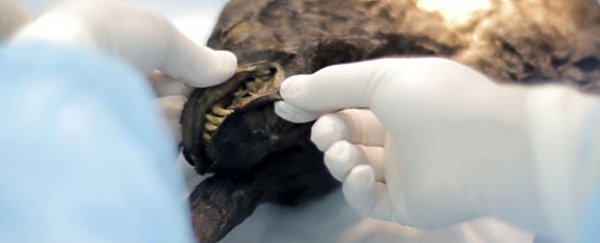Scientists have managed to thaw out and perform an autopsy on an ancient frozen puppy, which was mummified in the Russian permafrost some 12,400 years ago.
Discovered in an icy grave near the village of Tumat in the Sakha Republic of Russia last year, the 'Tumat Puppy' appears to be an extinct species of canine, and with its surprisingly well-preserved brain, there's a possibility that it could be cloned back to life.
"The carcass is preserved really very well. And one of the most important things is that the brain is preserved," one of the team, Pavel Nikolsky from the Geological Institute in Moscow, told Anna Liesowska at The Siberian Times.
"The degree of preservation is about 70 to 80 percent. We will be able to say more precisely after it is extracted. For now we can see it on MRI scans," he added. "Of course, it has dried out somewhat, but the both parencephalon, cerebellum and pituitary gland are visible. We can say that this is the first time we have obtained the brain of a Pleistocene canid."
Believed to have been someone's pet at the time of its death, the Tumat Puppy was mummified near what appears to be an ancient human settlement in the Ust-Yansky district of the Sakha Republic, overlooking the River Syalakh.
It's thought that the Tumat Puppy could have come from the same litter as the Tumat Dog - another puppy, believed to be a three-month-old female, found sealed in permafrost at the same site in 2011, and dated to around the same time.
Like the Tumat Puppy, the Tumat Dog was remarkably well-preserved - its bones, heart, lungs, and stomach are all still intact, despite being named the oldest mummified puppy in the world at the time. Both puppies are thought to have died in a landslide close to the river.
While the information scientists can glean from the two ancient puppies' remains will give us an invaluable insight into life in the area 12,400 years ago, the Tumat dogs might have a larger role to play, if South Korean scientist Hwang Woo-Suk gets his way.
Present for the Tumat Puppy's autopsy, Woo-Suk is a controversial cloning expert, having led efforts to resurrect woolly mammoths and an exinct cave lion. "He's also building an animal cloning facility in China and has held a dog-cloning competition in the United Kingdom," Discovery News reports.
Depending on the quality of tissue and DNA the team can extract from the thawed-out specimen, Woo-Suk says there's a possibility of 'resurrecting' the extinct species of canine. He's taken the best preserved skin, muscle, and ear catilage from the Tumat Puppy, and will be analysing their potential.
"This puppy is better preserved than the previous one, so we hope to get more new information," one of the team, Sergey Fedorov from Russia's North-East Federal University, told The Siberian Times. "Professor Hwang Woo-Suk was also satisfied with the degree of preservation. He was very exсited."
The team will also be examining the Tumat Puppy's intestines to see if they can extract any ancient species of ticks and fleas.
It probably goes without saying that the chances of the Tumat Puppy being cloned are likely to be pretty slim, given Woo-Suk's history of not finding much success in his big plans, but we'll have to wait and see.
In the meantime, you can watch the autopsy below:
